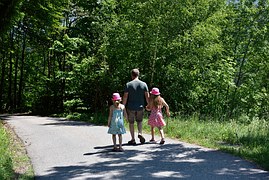We’ve all seen the statistics: Being actively involved with our children reduces problems and leads to positive outcomes. One area that often leads to a disconnection in this area is with non-custodial parents. This is (statistically) often the father.
Child support plays an important role in the finances of many families, both for the custodial parents or other family members caring for children who receive payments, and for the noncustodial parents (usually fathers) who pay child support. Both can benefit greatly from financial education and from access to asset-building tools such as Individual Development Accounts (IDAs).
 Towards that end, OSU Extension is proud to report that they are one of three organizations selected in the state of Ohio to receive funding from the Ohio Department of Commerce. OSU Extension will use this grant funding to help non-custodial parents, especially fathers, gain access to financial education, counseling and economic empowerment opportunities, thereby helping them remain compliant with the orders of the court, but moreover remaining active in the lives of their children.
Towards that end, OSU Extension is proud to report that they are one of three organizations selected in the state of Ohio to receive funding from the Ohio Department of Commerce. OSU Extension will use this grant funding to help non-custodial parents, especially fathers, gain access to financial education, counseling and economic empowerment opportunities, thereby helping them remain compliant with the orders of the court, but moreover remaining active in the lives of their children.
Studies have shown that non-custodial parents (especially fathers) who are actively involved in the lives of their children have a positive impact on the health, behavior, grades and delinquency of their children. Do you know someone (or an agency) who could benefit from getting involved? Please contact us. For details, call Susan Colbert at (614) 247-1983.
(Submitted by Susan Colbert, Program Director, Franklin County Expansion and Engagement)
 Obviously some of our social inventions for working together, resolving conflict, sharing resources and living together have not worked so well. We still settle some of our differences through violence, and there is still racism, prejudice and greed. There are far too many people who live in poverty, lack adequate food, water, education and medical care. However, looking at the facts we can see a decline in all these categories. In the area of hunger we now produce enough food to feed everyone in the world but not everyone has enough food, so we need to invent a new worldwide food distribution system. What we forget is that we invented the current worldwide food system and that
Obviously some of our social inventions for working together, resolving conflict, sharing resources and living together have not worked so well. We still settle some of our differences through violence, and there is still racism, prejudice and greed. There are far too many people who live in poverty, lack adequate food, water, education and medical care. However, looking at the facts we can see a decline in all these categories. In the area of hunger we now produce enough food to feed everyone in the world but not everyone has enough food, so we need to invent a new worldwide food distribution system. What we forget is that we invented the current worldwide food system and that 
 As a result of this devastation, local officials, agencies and residents began an initiative to establish a flood warning system for Duck Creek. After several years of research and evaluation, a system consisting of various stream and rain gauges, computer monitoring equipment, transmitters and associated enclosures was designed. In 2012, installation was complete and the system became operational. This system provides real-time data for the National Weather Service and can be accessed via
As a result of this devastation, local officials, agencies and residents began an initiative to establish a flood warning system for Duck Creek. After several years of research and evaluation, a system consisting of various stream and rain gauges, computer monitoring equipment, transmitters and associated enclosures was designed. In 2012, installation was complete and the system became operational. This system provides real-time data for the National Weather Service and can be accessed via 

 In a 2004 article in the journal Psychological Science, J. Richard Hackman contends that effective team members are people who possess the emotional maturity needed for their roles with their teammates. His research shows that fostering emotional maturity is essential; however, it is a trait that tends to be developmental in nature and cannot be readily taught. Well, you’ll get no argument here. In fact, while many institutions of higher learning offer degrees in neurology or engineering, we’ve yet to see a university that offers a degree in emotional maturity.
In a 2004 article in the journal Psychological Science, J. Richard Hackman contends that effective team members are people who possess the emotional maturity needed for their roles with their teammates. His research shows that fostering emotional maturity is essential; however, it is a trait that tends to be developmental in nature and cannot be readily taught. Well, you’ll get no argument here. In fact, while many institutions of higher learning offer degrees in neurology or engineering, we’ve yet to see a university that offers a degree in emotional maturity. How can we work together to increase personal financial security, address poverty and create economic opportunity? OSU Extension – University District, in collaboration with the Ohio CDC Association and Ohio Department of Jobs and Family Services, has joined the
How can we work together to increase personal financial security, address poverty and create economic opportunity? OSU Extension – University District, in collaboration with the Ohio CDC Association and Ohio Department of Jobs and Family Services, has joined the  OSU Extension is able to provide supportive services to Franklin County BAFF participants in collaboration with community, civic, corporate, collegiate and church partners. These programs and services include
OSU Extension is able to provide supportive services to Franklin County BAFF participants in collaboration with community, civic, corporate, collegiate and church partners. These programs and services include